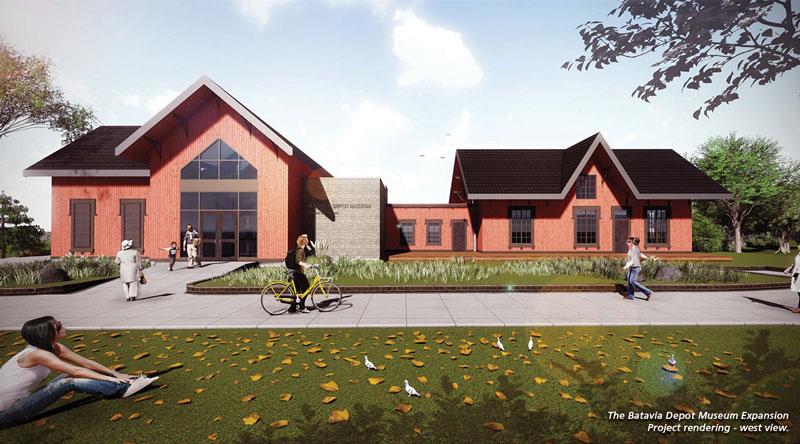Batavian John Gustafson and his brothers and sisters were first to see the vision of a viable Batavia Historical Society when they began gathering and cataloging Batavia artifacts in 1959. By 1960, the Batavia Historical Society was established and its mission remains to collect, preserve, study, interpret, and exhibit materials in the Depot Museum.
In 1969, twenty local businessmen donated $50 each to purchase the abandoned C.B. & Q. passenger depot on South Van Buren Street to house historical society collections. In 1973, the Depot was moved from Van Buren Street to its present home on Houston Street. The C.B. & Q. caboose was moved to the Museum campus two years later.
By the time the Depot Museum was dedicated in 1975, almost half the people in town had contributed to the project through their dollars, artifacts, skills or other talents. By 1979, the Depot Museum was listed on the National Register of Historic Places.
The Museum is a cooperative effort between the Batavia Park District and the Batavia Historical Society. Volunteers donate more than 1800 hours each year and the Museum has over 4000 visitors every year including residents, students, and visitors.
As the community has grown, the collection of historical materials has grown and the needs of the community have evolved. The Gustafson Research Center opened in 2000. It is aptly named in honor of John Gustafson and his family who helped establish the Batavia Historical Society. The Center was added to the Museum to provide a dedicated space for the large collection of historical documents and to make these documents accessible to researchers.
The Depot Museum is ideally located close to cultural and civic landmarks, galleries, and outdoor activities.
1. Depot Museum
2. Proposed Flag Day Monument
3. City Hall / Appleton Mfg. Building
4. Library
5. Water Street Studios
6. Depot Pond
7. North Point Pavilion / Dam
8. River Street District
9. Wilson Street Bridge
10. Clark Island
11. Peg Bond Center/Performing Arts Pavilion
12. Harold Hall Quarry Beach
* Dining opportunities
* Bicycle and pedestrian trails


While most of our visitors come from the immediate area, over 35% of them are from out of state or other countries. How will a 5,000 square foot expansion serve this diverse group of visitors?
• The ability to host traveling programs from national museums.
• The “Welcome to Batavia Center” will be the cornerstone of the Batavia Riverwalk.
• An enhanced set of educational opportunities for interns and advanced study students.
• We’ll fulfill our commitment to meet the needs of the growing and evolving community.
With this expansion, we will continue our mission and ensure relevance for future generations.






Photos provided by The Batavia Depot Museum appear in the National Archives “Rod Ross Memorial Day” video. Having spoken at the museum’s dedication, I knew it was the place to go for the images we needed to complete our project. Another link to the museum is the marble-topped dresser, donated by my family, presumably used by Mary Lincoln in Bellevue during her residence in Batavia’s Bellevue Place Sanitarium. I’ve left Batavia, but Batavia has never left me. Good luck with the campaign.
Rodney Ross – Retired Archivist, Center for Legislative Archives, National Archives
I am text block. Click edit button to change this text. Lorem ipsum dolor sit amet, consectetur adipiscing elit. Ut elit tellus, luctus nec ullamcorper mattis, pulvinar dapibus leo.
I am text block. Click edit button to change this text. Lorem ipsum dolor sit amet, consectetur adipiscing elit. Ut elit tellus, luctus nec ullamcorper mattis, pulvinar dapibus leo.



